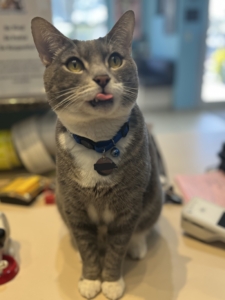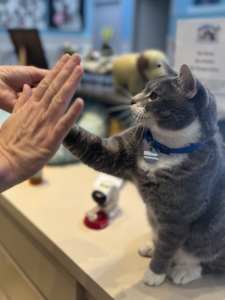Commitment to Care:
Unleashing the Potential: Why Training Your Cat Matters!
Unleashing the Potential: Why Training Your Cat Matters!

When it comes to pet training, the spotlight often shines on our canine companions. However, did you know that training your feline friend is just as crucial? Cats are intelligent animals, and with a little patience and some tasty incentives, you can train them to exhibit positive behaviors while providing mental stimulation.
The key insight here is that cats do not grasp the concept of punishment. It is far more impactful to promote positive behavior. Positive reinforcement is the key, whether you are training a dog or a cat. Identify what motivates your cat: treats, praise, or affection and use it to reinforce good behavior. Marker training, involving a click or a verbal cue followed by a treat, this helps your cat understand exactly what you appreciate about their actions. Teaching your cat commands like “sit” and “high five” not only adds an element of fun to your relationship but also forms the foundation for other learned behaviors.

However, before you jump right into cat training it is essential to consider some basic aspects of feline training. Optimal training sessions should coincide with moments when your cat is calm and hungry, as this heightens the temptation of treating as incentives. Create a quiet environment free from distractions to ensure your cat remains focused on the training. Carefully select a motivating reward, whether it be food, play, or affection. Acknowledge and adapt to your cat’s limited attention span by keeping training sessions brief initially and gradually extending their time. Experiment with the efficacy of clicker training or the use of a short verbal command. Clicker or verbal command training can be effective, marking desired behaviors with a click or word. Here is a step-by-step guide to training your cat to sit:
Training Your Cat to Sit:
- Hold the Treat or Toy: Secure the treat or toy between your fingers, adjusting based on your cat’s motivation level.
- Position Yourself: Stand or kneel in front of your cat with the treat a short distance from their nose.
- Lift the Treat: Slowly lift the treat a few inches upward, prompting your cat to follow it with their gaze.
- Move Backward: Gradually move your hand (with the treat) toward your cat’s tail, encouraging a natural sitting position.
- Say “Yes!” (or click): As soon as your cat sits, mark the moment with “Yes!” or a click, followed by a treat.
- Repeat and Reinforce: Repeat the steps until your cat associates sitting with receiving a treat.
- Add a Verbal Cue: Introduce a verbal cue like “sit” and reinforce with the marker and treat.
- Teach Hand Signal: Optionally, incorporate a hand signal alongside the verbal cue and gradually fade the verbal command.
- Increase Distance: Challenge your cat by increasing the distance before asking them to sit and extend the duration of the sitting behavior.
- Intermittent Rewards: Gradually reduce treat frequency while maintaining verbal praise, making your cat respond to your commands with joy.


Now that your cat has the basic sit command down and is comfortable with his or her training you can now move on to another trick. Another fun task for you to train your cat to do is High Five. Cats often use their paws to touch items in front of them, this is what makes the high-five so easy for most cats.
Training Your Cat High Five:
-
- Keeping your hand flat, showing your cat your palm, just like you are going to High Five a human. This will encourage your cat to reach toward you. Make sure it is not too far away that your cat cannot touch your hand.
- Wait for your cat to touch your hand with his or her paw. This will require some patience.
- The second you feel your cat touch your palm with his or her paw, click your clicker or say, “High Five” and give the treat.
- Remove your hand. After waiting a few seconds, repeat steps 1,2, and 3 until your cat is comfortable performing this task.
Training your cat may take time, but the bond you build and the positive behaviors you instill will be well worth the effort. Happy training!
